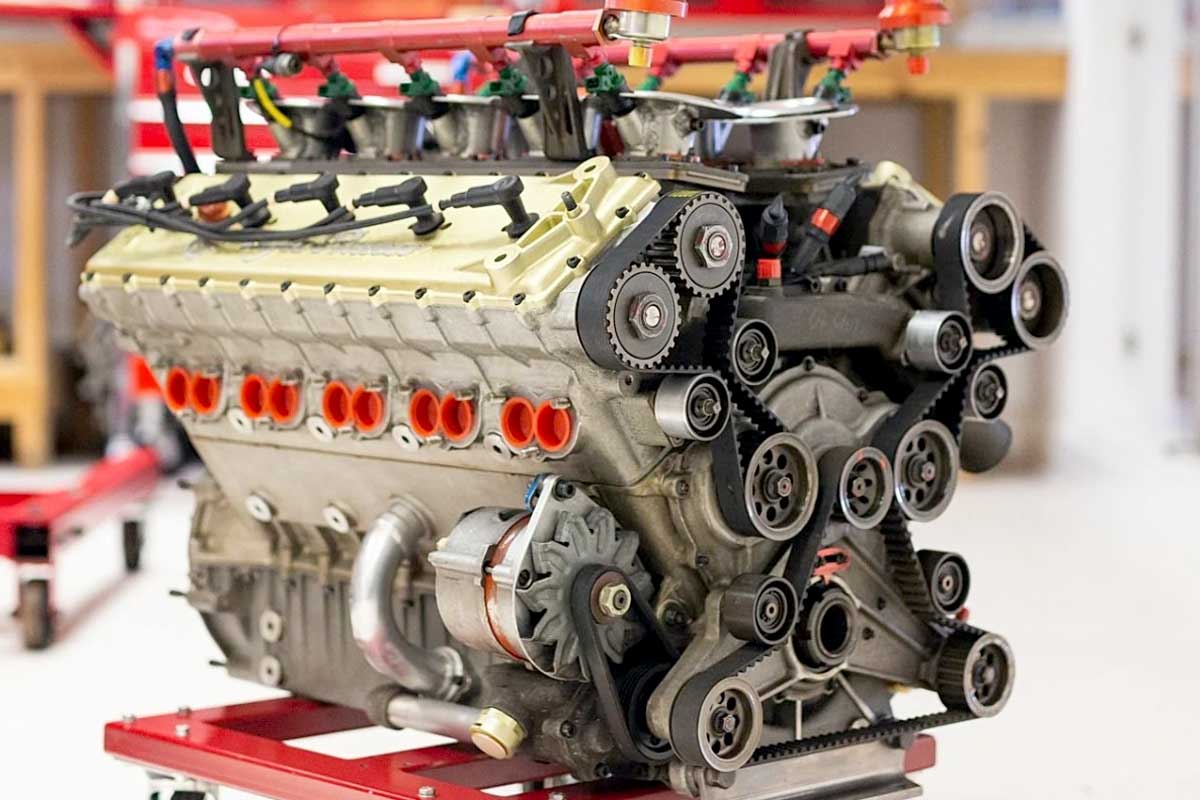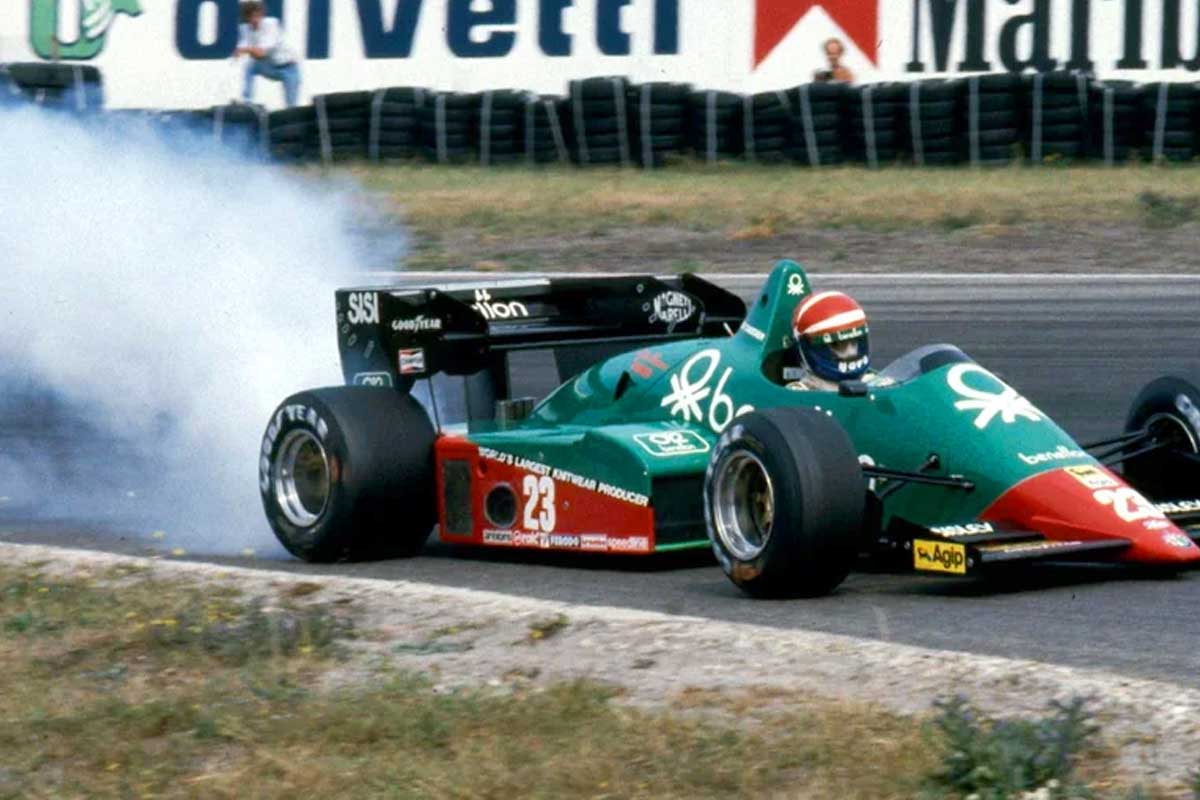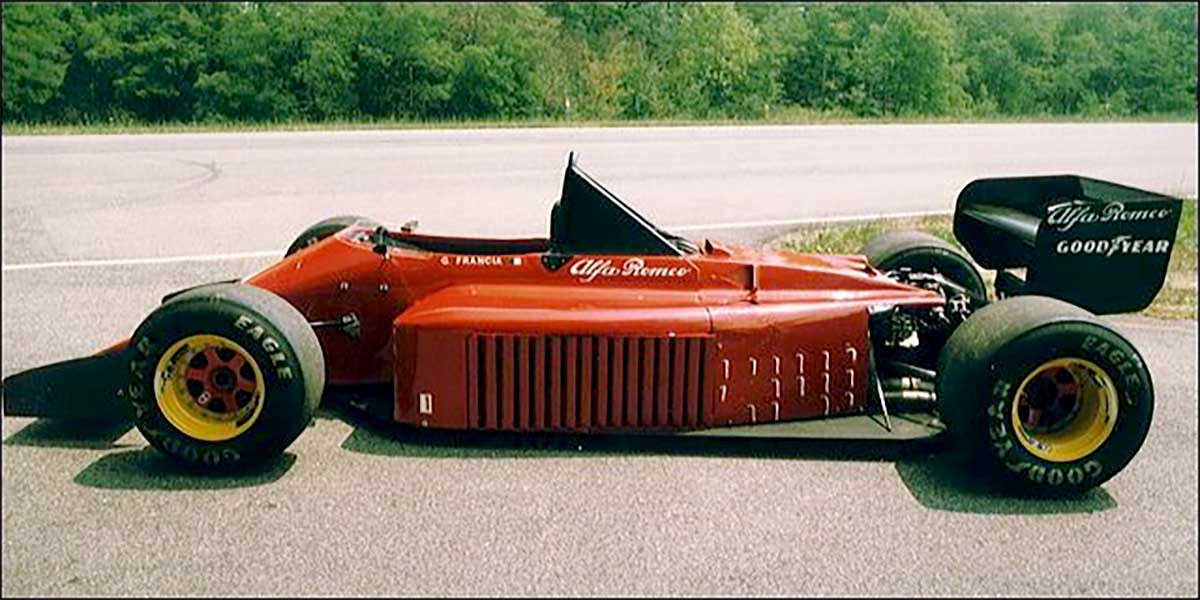
25 years after the exploits of the legendary Alfetta 159, Alfa Romeo had returned to F1 in 1976, first as Brabham's engine builder with a 12-cylinder flathead, then, from 1979, with an in-house 100% project based on a 3-liter, 60° V12 engine more suited to ground-effect cars. Despite its financial difficulties, the Biscione persisted and Autodelta developed a turbo engine for the 1983 season. Except that Carlo Chiti's choice of an 8-cylinder, while most other engine manufacturers opted for a 4-cylinder or 6-cylinder, proved unsuitable. The powertrain was too heavy, penalized by turbines with excessively long response times and an unfortunate tendency to overheat. More efficient KKK turbines had been tested, but for "political" reasons, models from the Alfa Romeo Avio subsidiary were preferred. Initially, the engine had no electronic fuel injection, Alfa Romeo having preferred an internal mechanical solution, which led to problems of over-consumption and poor management of the air-fuel mixture, the cause of numerous breakdowns.

In 1983, the Biscione enjoyed its best season of the "turbo era" with a number of podiums, but reliability was very uncertain. The switch to KKK turbos and Bosch electronic fuel injection in 1984 did not work miracles.

Worse still, the 1985 season was simply catastrophic, with zero points in the championship. At the end of the season, Alfa Romeo quietly withdrew. The brand continued to supply its 8-cylinder turbo engine to the small Osella team, but in 1988 demanded that the engine be renamed Osella, so as not to tarnish the Biscione's image too much with single-seaters at the back of the grid, or even in non-qualifying positions!
A V10 in F1 for Ligier? No !
Despite the team's failure, Alfa Romeo didn't give up on F1 for all that, and in 1985 developed a new 4-cylinder turbo. In 1986, a partnership was signed with Ligier, which had had enough of paying too much for its overpriced Renault V6s. That year, the tragic death of Elio De Angelis at Le Castellet acted as a detonator: FISA announced that turbo engines would be restricted, then banned at the end of the 1988 season, to be replaced from 1989 by naturally-aspirated 3.5-liter engines.
The deal with Ligier provides for the supply of a naturally-aspirated engine when the new regulations come into force. Since November 1985, Italian engineers have been working on a revolutionary naturally-aspirated engine never before seen in F1, a V10, which is already running on the dyno! Alfa Corse's technical director, Gianni Tonti, entrusted the engineer d'Agostino with the "Tipo 1035" project, which was to provide the best compromise between the compactness and sobriety of the V8 and the power of the V12. A little-known fact, Alfa was the forerunner of the V10 in F1, before Honda and before Renault, which launched its own studies in 1987 after withdrawing from F1 at the end of 1986. The V10 concept was considered promising, with an aluminum-silicon alloy cylinder block and cylinder head, aluminum pistons, and four titanium valves per cylinder (soon to be five), controlled by four camshafts with phase variators. In short, a sophisticated engine in the vein of the great engines of the past.

But as the 1987 season approached, it was all over! With René Arnoux, Ligier tested the Alfa Romeo 4-cylinder turbo, rated at 900 hp in its latest evolution. Testing at Paul Ricard proved disastrous, plagued by numerous technical problems. Annoyed, the French driver spoke out in the press, openly criticizing the engine's lack of competitiveness and questioning the professionalism of the technical team.
Humiliated by this slap in the face by the Italian media, Alfa Romeo terminated its contract with Ligier two weeks before the start of the season! Without an engine, the French team missed the 1st race of the '87 season, before having to fall back on the outdated Megatron V8 (ex-BMW) as a matter of urgency.
Bernie Ecclestone to the rescue
In reality, although René Arnoux's statements were used to justify the break-up, it was FIAT that put the brakes on, just after having bought and saved the Biscione from the wreck: it was out of the question for the Turin-based firm to see Ferrari and Alfa Romeo fighting it out in F1, especially as Alfa Romeo was in financial difficulties and urgently needed to modernize its range. FIAT boss Vittorio Ghidella never believed in the project, which was being carried out with limited resources, and jumped at the chance to pull the plug. The Biscione was left with a V10 engine that had cost a considerable sum to develop.
But fortunately, a Deus ex Machina appeared: Bernie Ecclestone! The latter, who has just been confirmed as the "king of F1" with the Concorde Agreement, is looking to get rid of a ball and chain: the Brabham team, which has become the least of his worries. Deprived of its brilliant engineer Gordon Murray and BMW, Brabham was a shadow of its former self. The "Concorde II Accords" guarantee the British company an absolute stranglehold on the F1 business, as well as a right of review over other FIA championships.
To liven up the F1 show, he is thinking of reviving the Procar championship, launched in 1979 as a curtain-raiser to the F1 Grand Prix, with the BMW M1. The concept? A spectacular Silhouette formula, inspired by Nascar, but with a more sophisticated F1 chassis and engines! What's more, it could perhaps overshadow Group C, the premier Endurance category, which is getting too big for his liking.
A V10 for a super Alfa Romeo 164? No !
Alfa Romeo, who had maintained good relations with Ecclestone, showed interest. This would allow them to fit in their famous V10 and promote their new Milanese sedan, the elegant 164. Even before the new Procar championship was clearly established, Alfa Romeo threw itself into the adventure and...bought Brabham from Ecclestone, so as to have a base from which to develop the chassis! Clever, Bernie!
The Alfa Romeo 164 Procar is built in 1988. With its lowered body, carbon wheels, rocker panels and rear spoiler, it was transformed into a muscular sedan for dad in a hurry. But behind the allure of a tuned sedan lies a real prototype: the chassis is a carbon monocoque with ultra-light Kevlar bodywork. The engine, in a central rear position, is the famous Alfa 3500cc V10 with a 72° angle, rated at 620 hp at 11800 rpm and an exuberant 390 Nm of torque at 9500 rpm.

Weighing just 750 kilos on the scales, the 164 was a real missile, which, during tests at Balocco, accelerated from 0 to 100 km/h in 2.1 seconds and reached 340 km/h, more than the F1 cars of the time! At Monza in 1988, the 164 Procar, driven by Riccardo Patrèse, put on a small demonstration on the bangs of the grand prix, to great public acclaim. But faced with the exorbitant costs of this new formula, no other manufacturer followed Alfa Romeo's lead. The Procar was a stillborn project and the Super 164 a prototype destined for the museum.
No more? No! again at Ecclestone's instigation, the FIA announced that from 1991, Group C sports cars would be governed by new regulations based on 3.5-liter naturally-aspirated engines, identical to those used in F1. The change in regulations comes as a surprise, but the authorities, while promising the most powerful prototypes ever designed, claim that it will cut costs and attract more brands.
An Alfa V10 at Le Mans? No !
Most automakers were in a holding pattern, but Alfa Romeo jumped at the chance. With Ferrari in F1 and Lancia in rallying, FIAT turned the Biscione towards sport-prototypes, giving its engine a new lease of life. It was also an opportunity for Alfa Romeo to return to a discipline where it had enjoyed success in the 70s with the Tipo 33.
A group of Abarth and Alfa Corse engineers set to work on the design of the prototype christened SE 048SP, for Sport Experimental 048 Sport Prototipo. Engineer Petrotta's elegant, efficient design is based on a carbon-fiber monocoque, with front-mounted radiators, drag-reducing rear wheel covers and streamlined, covered rear wheels. The silhouette is both sleek and futuristic, enhanced by a front grille featuring the famous Scudetto.

The engine was first tested on an old Lancia LC2, but the tests revealed that the Alfa V10, originally designed for F1 sprints, could not keep up in endurance racing. On several occasions, the engine's belt drive broke, resulting in countless bent valves and foreshadowing catastrophic reliability. With the cost of upgrading deemed prohibitive, FIAT's management ordered the "cursed" Alfa Romeo V10 engine to be scrapped, to be replaced by the 60-valve, direct-injection Tipo 036 V12 Ferrari engine, taken directly from the Scuderia's 641 single-seater. With 680 hp, the Ferrari engine was satisfactory in terms of performance, but it wasn't designed for long distances either.
Premature end
A new twist came in September 1990, when FIAT ordered that the project be abandoned altogether, following changes at the top of the management team. Gianpiero Moretti, creator of the MOMO equipment manufacturer, was in line to enter the 048SP in the American IMSA championship, but the deal fell through, no doubt precipitating the decision. Alfa Romeo then turned its attention back to touring car racing, with a new project, the 155 GTA, which was to have a bright future. In the end, the decision was a wise one, as the new 3.5-liter Group C formula quickly floundered and the world championship disappeared at the end of 1992. The Alfa Romeo V10 never got its chance...
